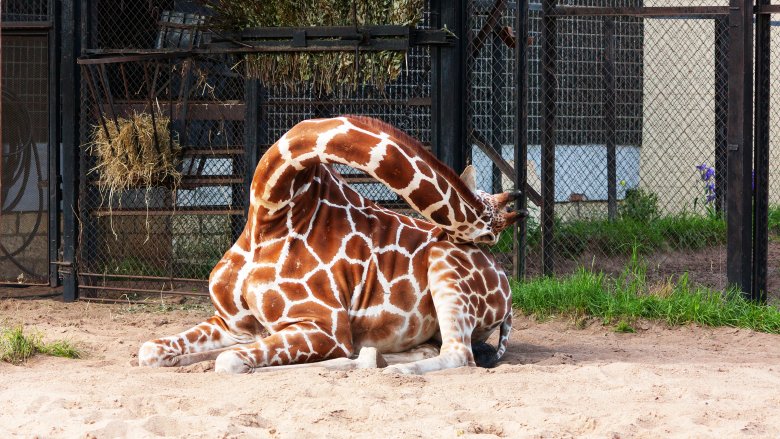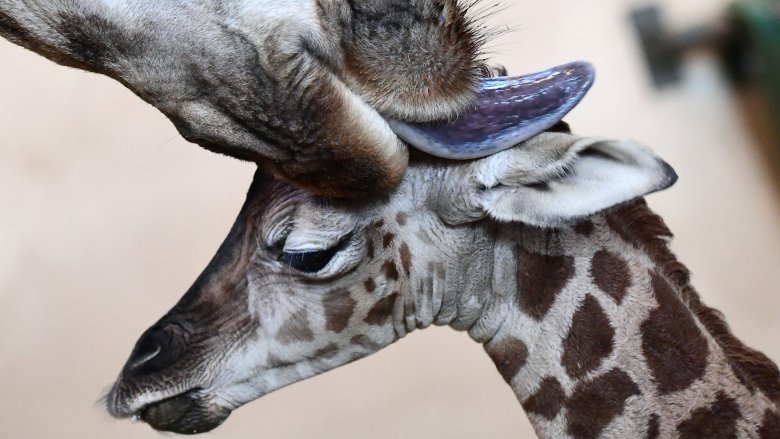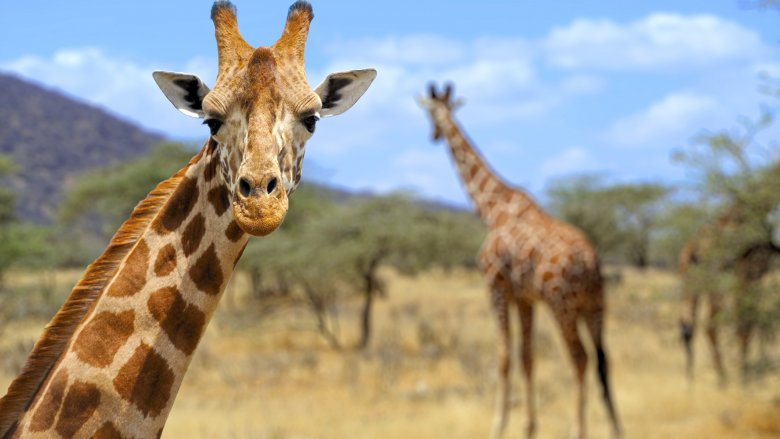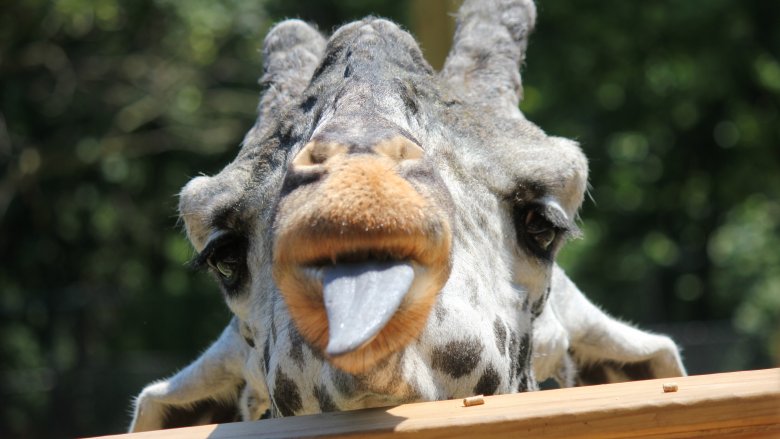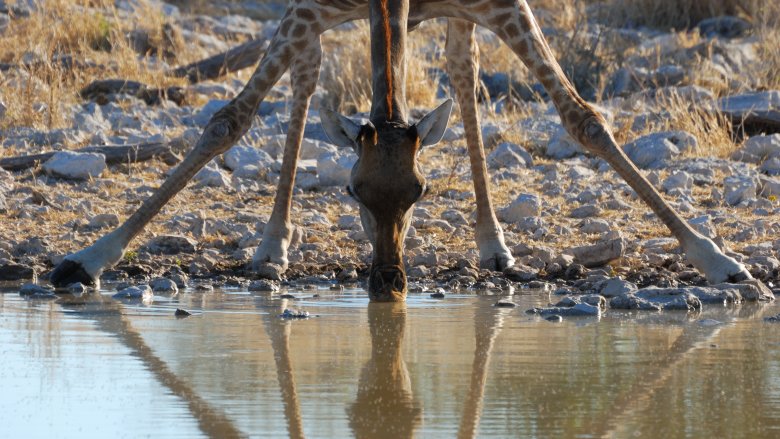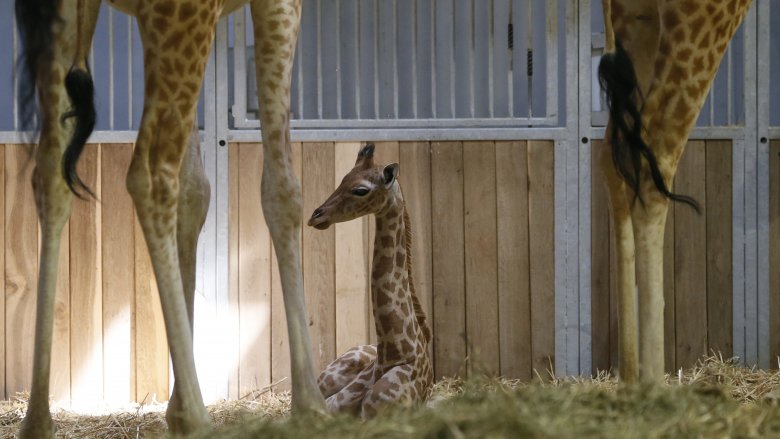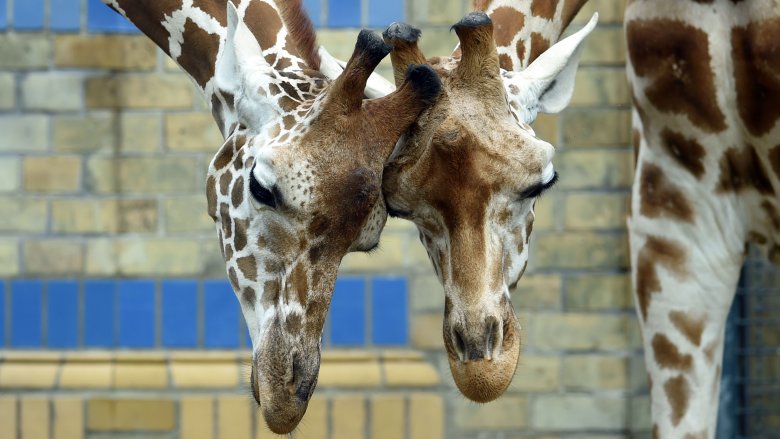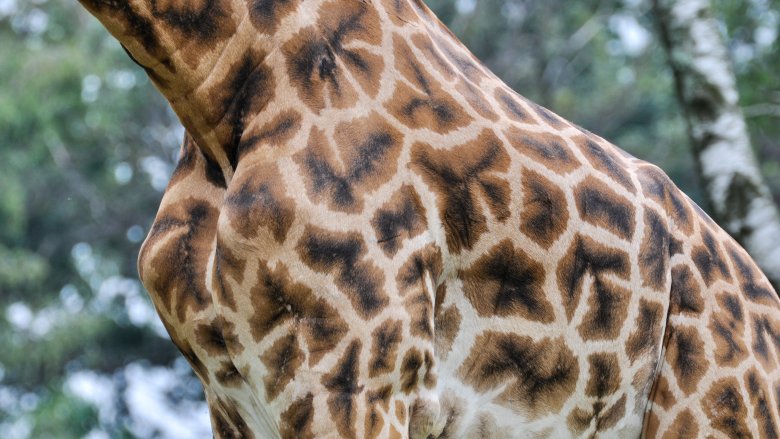Crazy Facts You Didn't Know About Giraffes
All animals are cool, in their own way. But giraffes are extra-cool, and they're so cool, in fact, if you look at them long enough you'll start to suspect there's no way they can actually exist. With those long necks, spindly legs, and weird tongues, they look like they defy at least a couple laws of biology and maybe even one or two from physics. But they do exist, and it turns out there's more weird stuff going on with them than you think.
They don't need much sleep, and can get it minutes at a time
Anyone who has a cat knows they sleep an insane amount of time (and that makes us jealous). Giraffes are sort of the anti-cat, and according to Nerdist, they sleep so little, it was once believed they didn't sleep at all.
That only changed in the mid-90s, when the University of Zurich spent 152 nights watching eight giraffes sleep. They found their adorable subjects only needed around four and a half hours of sleep every day, and most of their sleep happened in short spurts of between one and 35 minutes. A lot of the sleep happened while the giraffes—specially the older ones—were standing, but when they did lay down to grab about four winks (and the only time they get REM sleep), they rest their head on their butts in a position that makes them extra-cute.
You only wish you could get your sleep a few minutes at a time, but according to biologists from the Tierpark Berlin zoo, giraffes can still suffer from sleep deprivation. They get stressed for some of the same reasons we do, like traveling, loss of or separation from family members, and especially the loss of a partner. When one German giraffe, Jacqueline, lost her mate, she didn't get any REM sleep for three weeks. That's love...and heartbreak.
Julius Caesar brought the first giraffe to Europe
The scientific name for a giraffe is Giraffa camelopardalis, for a very cool reason. Julius Caesar brought the very first giraffe (possibly a gift from Cleopatra) to Europe in 46 BC, and according to contemporary records, the creature was so mellow it was walked like a dog on a leash. Most of the records describe the giraffe's unusual appearance, which must have been pretty shocking for anyone fortunate enough to see it in person. If you've ever wondered which came first, the internet or the troll, we know it was the troll because of the writings of a man named Gibbon, who called the giraffe "[...] the most useless of the large quadrupeds."
The Romans called it the camelopardalis, or the camelopard, because they thought it looked like a cross between a leopard and a camel—and we still call it that today. The fate of Caesar's giraffe isn't recorded, and according to the University of Chicago, it's unlikely the story about it being slaughtered as a display of power is the least bit true. Giraffes were killed for ancient Rome's entertainment but not until the second century AD, so we like to think Caesar's giraffe lived a long and happy life, strolling about Rome on a leash like the coolest dog ever. (No matter what Gibbon says.)
They lived in medieval China, and inspired legends of the Chinese unicorn
The medieval explorers of China were sailing circles around Europe's best, and in 1413 a fleet dispatched to India met up with another fleet from Malindi, which is now Kenya. The African fleet had brought along some exotic animals to give as tribute to the people they met, and they gave one of their giraffes to the Chinese. A few more expeditions happened, and it wasn't long before a whole menagerie of African animals were living in China.
According to accounts compiled by Science News, the giraffe wasn't just a plain ol' exotic animal—it had a mythic quality. They were thought to be the qilin (also ch'i-lin), which are better known by the slight misnomer of a Chinese unicorn. They were said to be part horse and part dragon, had anywhere from one to three horns, a deer's body, an ox's tail, cloven hooves, and a gentle nature, making it easy to see why people might think the giraffe is a qilin in the flesh.
It's possible the giraffes even helped shape Chinese history; they were used by Yongle to help legitimize his claim that he was a true Ming emperor. His rule wasn't as secure as he would have liked, and having one of Confucian tradition's mythical beasts in his entourage was some major propaganda. It would have worked on you, and you know it.
There are four completely different species
You probably have a generic sort of giraffe in your mental picture-box, but there are actually four different species and a handful of subspecies. According to the Smithsonian magazine, when geneticists took skin biopsies from 190 giraffes across Africa, they found the different species are so genetically diverse they're like comparing a polar bear to a black bear. Officially, giraffe species include the Southern giraffe (with two subspecies), the Northern giraffe (with three subspecies), the Masai giraffe (pictured), and the Reticulated giraffe (via the Giraffe Conservation Foundation).
That brings up another question. Take a look at Kenya, and you'll find a few different types hanging out together. They won't mate and they won't create hybrid offspring, but if they're kept in the same zoo enclosure, they'll get busy gettin' busy and making babies. Researchers from the University of California, Los Angeles tried to figure out just why giraffe species didn't mix in the wild, and found even though territories overlap, each species lived mainly in different "rain pockets."
The regional changes in rain patterns produced a different green season and, ultimately, a different baby-making cycle for each species. That means even if Dotty the Masai Giraffe fell for Buddy the Reticulated Giraffe, their reproductive cycles would be on different timetables. It's much more foolproof than just telling lovestruck Dotty that he's from the wrong side of the tracks, and no good for her.
They're quickly heading toward the endangered list — and one is already there
In 2017, wildlife protection groups added another animal to the list of species they campaign for—the giraffe. According to Scientific American, they cited studies showing wild giraffe populations declined by as much as 40 percent in the past 30 years, and have appealed to organizations like the US Fish and Wildlife Service to recognize the threatened status of the giraffe.
Wait, you're saying. Why would the US recognize the need to protect an African animal? Because the US isn't helping matters, with the demand for hunting trophies and giraffe skins helping to drive both legal and illegal hunting.
They estimate there's less than 100,000 giraffes left in the wild, and one species is already listed as endangered. The Rothschild's giraffe (pictured) was red-listed by the International Union for the Conservation of Nature in 2010, when there were around 670 individuals left (via the African Wildlife Foundation). They're all on the decline because of things like loss of habitat and poaching, and seriously, humans, stop being such jerks.
They hum, and they hum all night long
There's one sound that no one knows, and contrary to popular belief it's actually, "What does the giraffe say?" In 2015, researchers from the University of Vienna and Berlin Tierpark published the results of their study to determine precisely that, along with whether or not giraffes have a vocal communication system. Those who work with giraffes variously report them making sounds like grunts, moos, and sneezes, but for the most part, they're pretty quiet even though we know they have all the proper throat equipment they need to make noises.
And they do make noise—a lot of it. Check out that video of the so-called giraffe "hum"—a sound they make mostly at night. Before haters start hating, it's not surprising we haven't heard this before. Our hearing range goes from about 20 to 20,000 Hz, and since these went as low as 35Hz, the hum is at the very edge of what we can hear. When researchers played the tapes back for keepers and other zoo employees, they'd never heard the sounds before.
Researchers weren't sure just what the sounds meant, but can we talk about insane that sound is? If that was used as a sound effect for the next Jurassic Park movie, you wouldn't question it in the slightest.
We found a white one in 2015, and she's awesome
There are some moments we're just so darn jealous of, and this is one of them. In 2015, Wild Nature Institute reported seeing a newborn giraffe in the Tarangire National Park in Tanzania. She wasn't an ordinary giraffe, though—she was white. National Geographic says she's been spotted a few more times, and we're pretty sure a photograph just doesn't cut it. She has a condition called leucism, which means her skin doesn't produce color but other parts—like her eyes—still do.
Tour guides named her Omo (after a laundry detergent, because humor), and she's beaten some serious odds. She had around a 50-50 chance of seeing her six-month birthday even as a regular, boring old giraffe, and her awesome appearance means she's got some wardrobe malfunctions as far as camouflage goes. That's not even getting into how desirable her skin would be once it's removed from her, so when she was seen again in 2016, people were stoked. You go, little Omo! We're rooting for you.
We don't know why they have long necks
We don't need to tell you giraffes have a pretty notable physical feature, but what's super-interesting about their long necks is no one knows exactly why they have them. But, you were told this one in school, right? They evolved long necks so they could graze in the treetops. Unfortunately for you, your science teacher wasn't always right, and there's still a fascinating debate going about this one.
According to BBC Earth, the idea giraffes evolved their necks to become tree-grazers came from an 1809 treatise that said giraffes had stretched to graze on the treetops so much they'd stretched themselves right into long necks. Darwin simply said giraffes with long necks were more successful at surviving and reproducing, until they were all that's left.
Sounds legit, but according to the zoologists who set out to debunk the theory in the 1990s, there's a huge problem with it: giraffes actually prefer eating from lower shrubs. That gave rise to another theory, one stating a long neck gave male giraffes an advantage when it came time to fight for the ladies' attentions. Necking—seen in the video—is a bizarre kind of giraffe MMA, and giraffes have been known to kill each other doing it. The bigger the male, the better the fighter, and the more successful he is at, ultimately, mating. This theory isn't widely accepted, either, and that just means we have no clue why giraffes have long necks.
They have a wild circulatory system to cope with that neck
The giraffe's neck is something that gets stranger the more you think about it, especially when you start considering there's a lot of stretch between the brain and the heart. According to Professor Graham Mitchell of South Africa's Centre of Wildlife Studies (via the BBC), the giraffe's specialized circulatory system starts with its heart.
Contrary to a long-standing belief that a giraffe must have a huge heart, the giraffe's heart isn't any bigger than that of similar-sized animals. Instead, the walls of the heart are extra-thick to deal with the immense pressure that builds up in lower half of the circulatory system, where the giraffe registers twice the blood pressure as other mammals. By the time you get to the head, though, the blood pressure has dropped so much it's about on par with what we see in humans.
Science is still unraveling all the mysteries of just how this all works, but they do know a giraffe's blood vessels can expand and contract to regulate the entire system. Plus, research out of CalTech found those same blood vessels also contain valves to keep the blood flowing in the right direction. When the giraffe lowers his head to drink, the elevation difference can be up to a staggering 20 feet. The valves keep the blood from settling between heartbeats, and if you were exposed to that kind of pressure change? Yeah, you'd pass out.
They helped us work out the logistics of space travel
It's no exaggeration to say it takes a massive mental leap to go from space travel to giraffes, but that's what NASA did in the 1980s. They were looking at the problems astronauts experienced when they were coming home—going from a low-gravity environment back to a higher one created some problems. Essentially, the increased gravity pulls blood back into the lower extremities, meaning fainting and dizziness as the body re-acclimates to this new environment. According to Mental Floss, it was a physiologist named Alan Hargens who realized baby giraffes go through the same thing when they're born, and he and his colleagues studied their blood vessels—and their ability to walk within an hour of hitting the ground—as inspiration for creating the Lower Body Negative Pressure Device.
NASA also looked at the circulatory systems of adult giraffes to figure out how to combat the challenges presented to astronauts under different gravitational forces, and ultimately used what they discovered in the design and construction of the space suit. Just goes to show, you find inspiration in the strangest of places.
Giraffe sex (and birth) is weird
Let's talk about sex, and just how weird the sex life of a giraffe is. We do mean in both a biological way and in fetishistic way, so buckle up.
First, biology. Most animals have a mating season, but according to Popular Science, giraffes don't work like that. Their reproductive cycle is more like a human woman's, which means fertility goes in a year-long cycle. And that means males want to find out if their special little lady is fertile before investing a lot of time into courtship, so after he approaches her...this is where the fetish stuff comes in. She pees after his display of interest, and he can tell by the taste whether or not she's fertile. Regardless, she still wanders off and leaves him to chase after her if he's interested. In all fairness, she's going to stay pregnant for up to 460 days, so you can't blame her if she's debating whether or not those few seconds (literally) are worth it. And, since they give birth standing up, babies are introduced to the world with a head-first fall from six feet up. That's how we feel most days, too.
Awesomely, giraffes have also been recorded pairing up in a high number of same-sex couples, and even though the "94 percent" statistic you may have heard is likely wrong, the fact remains there are a large number of males observed sexing it up.
They can contract a mysterious skin disease
In the mid-90s, researchers started identifying the symptoms of a mysterious disease sweeping though giraffe populations across Africa. This is going to get gross, but you can't say you weren't warned. The disease is characterized by huge holes that are eaten into the giraffe's skin, and according to one infectious disease researcher, that's a big deal.
Kali Holder of the National Zoo's Global Health Program says when an animal's skin is compromised, one of their most important defenses is damaged. These lesions are caused by a tiny parasite you can hardly see, but the damage is insane. Not only does it expose the giraffe to all kinds of other infections, but there could be a host of problems including pain, stress, sleeplessness, and a disruption to their general schedules. Considering their numbers are already dwindling, this weird disease might have all kinds of consequences...and that should make you sad as well as squeamish.
